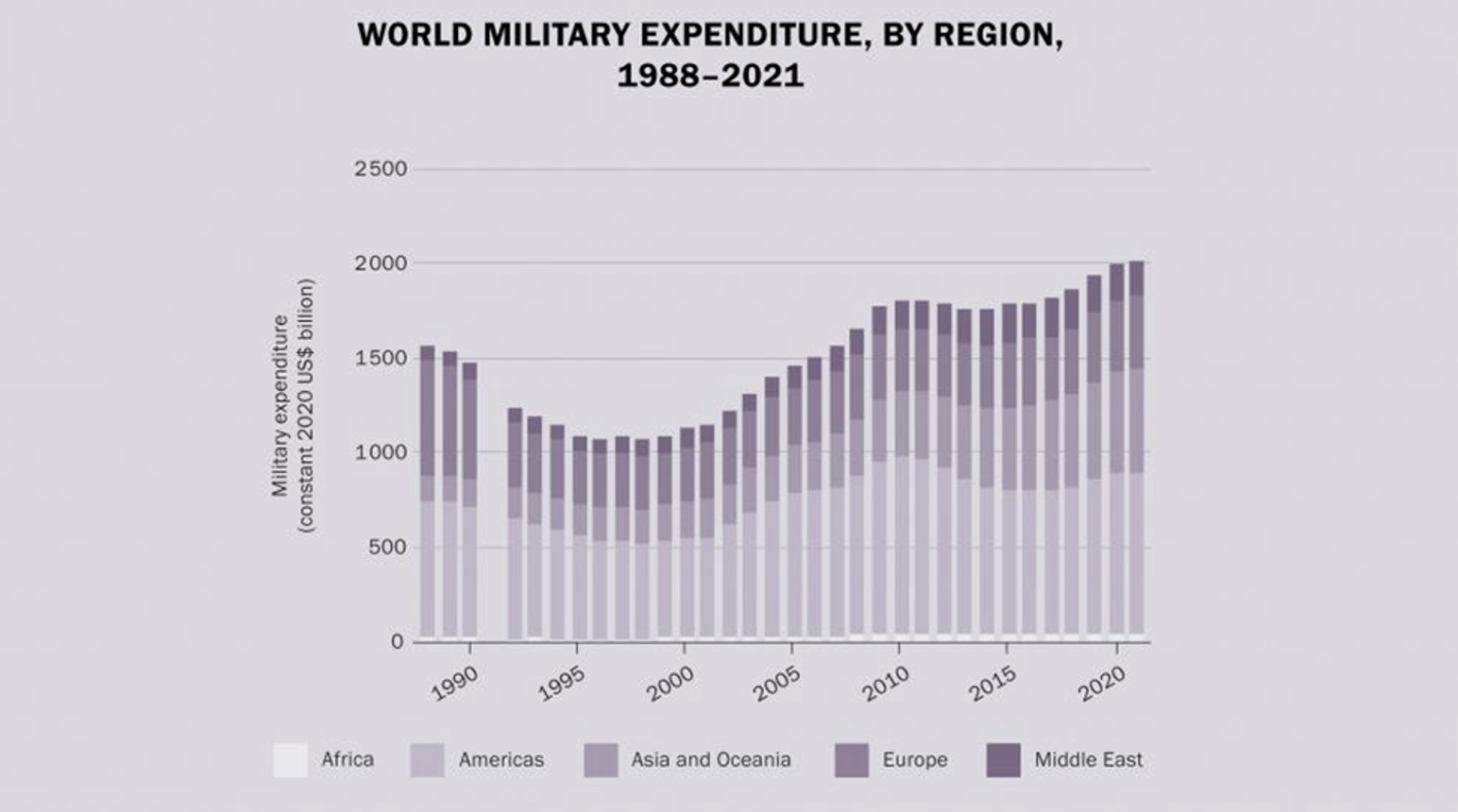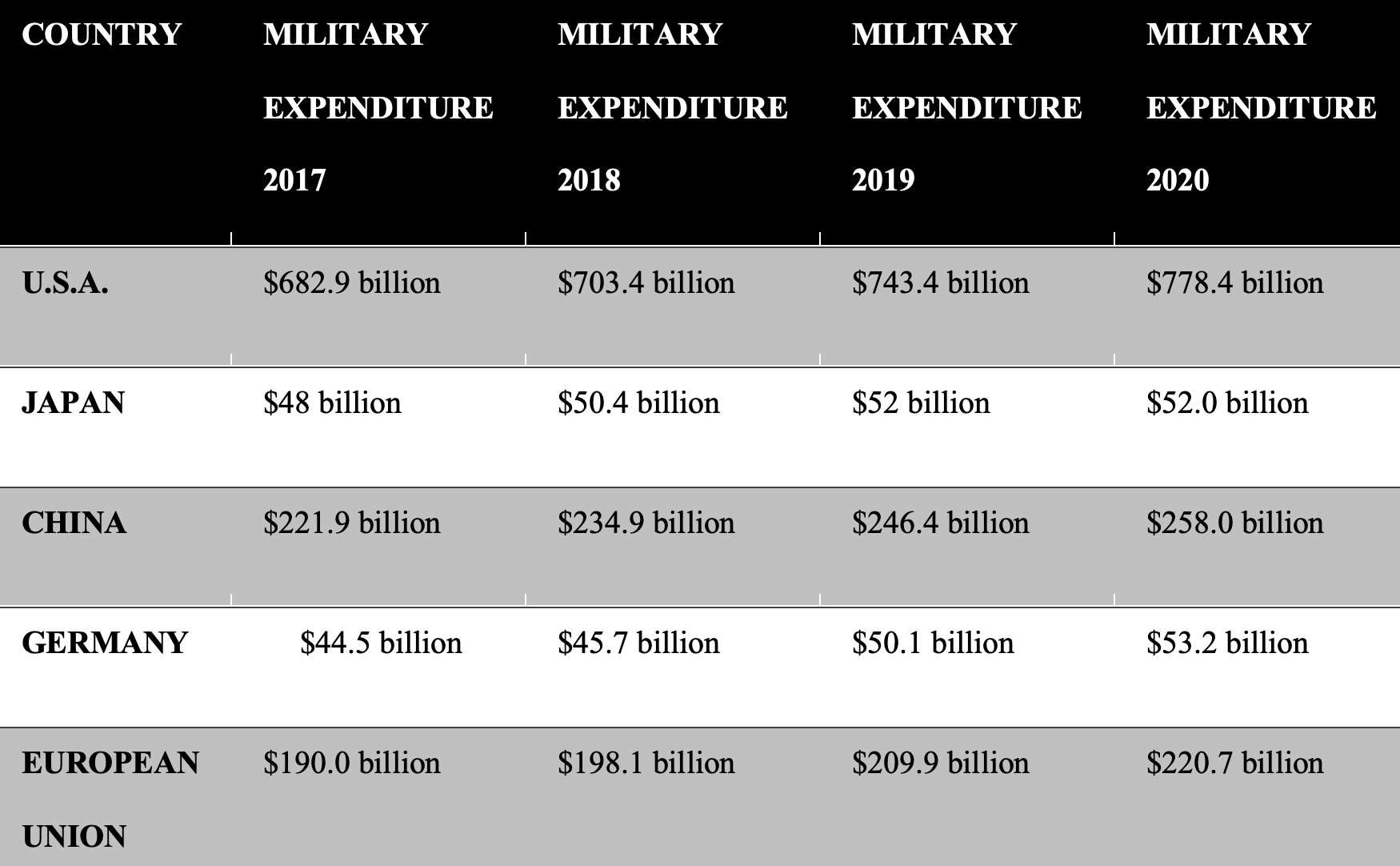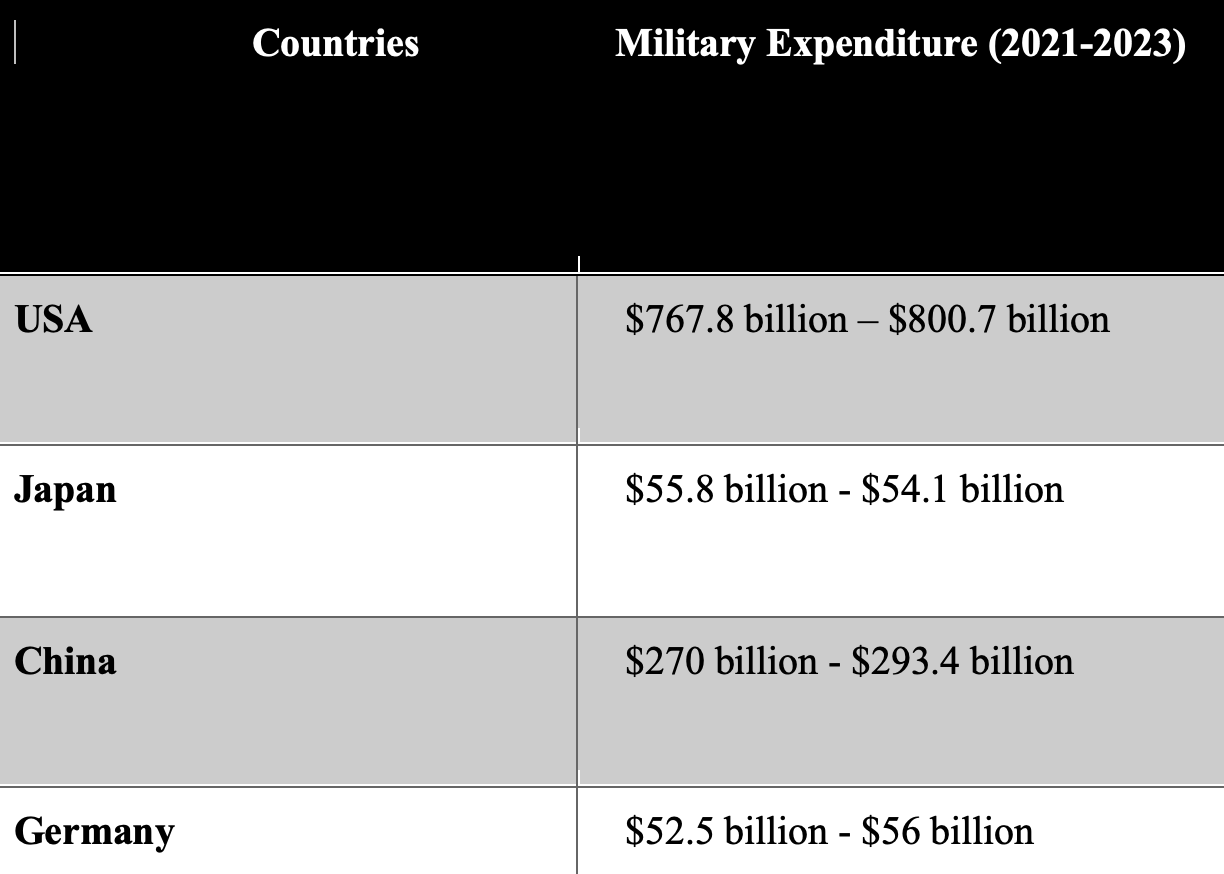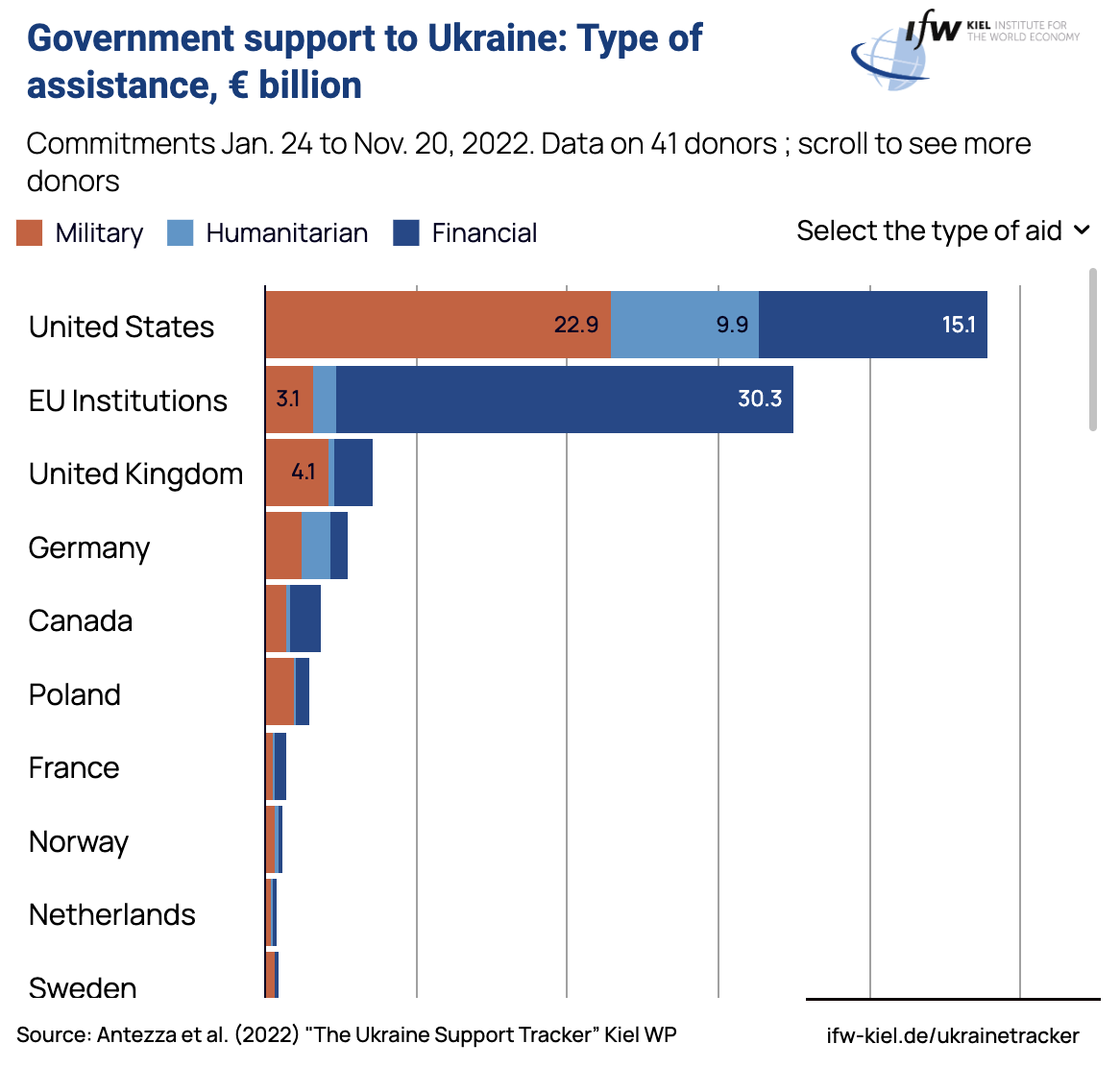Key Takeaway: To a very real extent, this is the unwinding of the 1990s peace dividend when the Berlin Wall fell and the United States reduced military spending.
As the major US defense contractors release their earnings this week, we thought it’d be a great time to release an overview of global defense spending. Clearly, the Ukraine war is the catalyst for governments increasing their allocations to this sector. For Europe, it’s a daily Russian existential threat given the proximity of the conflict. For Taiwan, it’s a daily existential threat of China engaging in military exercises bumping into Taiwanese airspace and practicing an amphibious landing. For Japan, a daily existential Chinese threat coupled with the odd North Korean nuclear and missile testing. In short, there’s a threat a major military conflict in almost every part of the world today.
If you think about economic growth over the last 20 years, we’ve had four important stabilizing factors: low inflation, low interest rates, ample labor and stable geopolitics. All four have changed. Inflation has soared, interest rates have risen, labor supply has been reduced and a major military conflict has occurred. Increased defense spending is emblematic of this last change.
This increase should be noted for the growth opportunity of the defense sector. It should also be noted it comes with the risk of greater additional military conflict and risk of fiscal pressure during a time of a US debt ceiling fight.
Introduction
The Russia-Ukraine war has had a profound impact on the global defense industry, causing countries around the world to re-evaluate their military spending and strategic alliances. As tensions continue to escalate between the two nations, the need for advanced military technology and increased defense budgets have become a top priority for many governments.
Prior to the war, global defense spending had already reached unprecedented heights, with worldwide military spending reaching an all-time high of $2.1 trillion in 2021. However, the Russia-Ukraine war has caused an even greater increase in demand for weaponry, leading to military spending in 2022 surpassing 2.2% of the global GDP.

Source: STOCKHOLM INTERNATIONAL PEACE RESEARCH INSTITUTE (SIPRI)
The figure above shows the global military expenditure by region from 1988 to 2021. From 2014, there was a steady increase in global defense spending, and this reached an all-time high in 2021.
The war has had a far-reaching effect, causing not only the involved countries but also their surrounding neighbors and other nations to improve their arsenal to protect themselves, aid Ukraine, and ward off potential threats.
In this article, we will delve into the past, current and future state of global defense spending in the wake of the Russia-Ukraine war, examining the major players and their military capabilities following this escalating conflict.
GLOBAL DEFENSE PRIOR TO THE RUSSIA-UKRAINE WAR
Prior to the recent Russia-Ukraine war, defense spending was already rising. This trend is highlighted by the data in the chart below created by Visual Capitalist, which breaks down the military spending for the top 10 military spenders. (Style points for the plastic green army men!) The chart illustrates the stark contrast between the top spenders and the rest of the world, with the top 10 countries accounting for over 75% of global military spending.

European Union
Military spending in the European Union grew tremendously from $175.5 billion in 2014 to $230.4 billion in 2021, recording a steady upward climb. The European Union had plans to continue increasing its military expenditure to have a stronger military, although it was still far from the 2% NATO benchmark.
Germany
Germany experienced significant growth in its military spending from 2015 to 2021, although it still didn’t meet their promise to meet the 2% NATO benchmark. From 2015 to 2021, there has been a steady climb in its military expenditure, recording an increase from $38.17 billion to $52.5 billion.
Japan
Japan’s steady increase in military expenditure started in 2017 and has continued to climb till 2021, recording a growth from $48 billion to $55.8 billion.
China
According to data from Visual Capitalist, China’s military spending has been on a constant rise for 27 years in a row. The data shows that it has increased by over $148 billion, which is 100.2% since 2012. China has the second-highest defense spending in the world. Its total spending in 2021 made up almost 14% of the global military expenditure. Although China has increased its military expenditure for 27 years in a row and has the largest number of active military personnel, its military expenditure is dwarfed by that of the world’s highest defense spender, the United States of America.
United States of America
According to the data gathered by the Stockholm International Peace Research Institute (SIPRI), the United States of America has remained at the top of the list as the world’s biggest military spender since 1949. USA’s defense spending has also constituted over 30% of the global spending for the past twenty years. In 2021, USA’s military spending reached $767.8 billion, making up 38% of that year’s global spending.
The table below shows the military expenditure for global defense in the USA, China, Japan, Germany, and the European Union as provided by SIPRI Military Expenditure Database.

CURRENT STATE OF GLOBAL DEFENSE
The ongoing conflict between Russia and Ukraine has resulted in a significant increase in military spending across the globe. As tensions escalate and the potential for further aggression looms, nations are becoming increasingly vigilant in their efforts to maintain a state of readiness. Furthermore, nations that have provided support to either side in the war have been compelled to invest heavily in replenishing their own armaments. The situation serves as a stark reminder of the importance of military preparedness and the potential costs of inaction.
The Shift Effect of The Russia-Ukraine War on These Countries
The table below shows the 2021–2023 military expenditure of the USA, Japan, China, and Germany; detailing the shift in military spending due to the Russia-Ukraine war.

3 Major Areas of Increase
The Russia-Ukraine war has caused a lot of disruption to the global economy, especially since the world was just recovering from the blow suffered during the Covid-19 pandemic. From natural gas to diesel to crude, the war has affected energy supply and drove prices near 2007-2008 levels. The war has also greatly impacted food security and affordability, as well as the transportation and mobility of people and goods. The rise in energy had a cascading effect through almost every industry and ultimately contributed to a global inflation rise.
Military Collaborations and Contributions Due to The Russia-Ukraine War
The Russia-Ukraine war resulted in military collaborations between nations. The USA has given Ukraine security assistance totaling $8.2 billion since the war began with more promised. The European Union has also supported Ukraine militarily, politically and economically to help them fight against Russia. Germany has also halted its Nord Stream 2 gas pipeline project with Russia and sent weapons to Ukraine to show where their alliances lie. The Kiel Institute provides a fuller picture of the financial and military support below (in Euros).

However, China has collaborated with Russia, sharing technology, military intelligence and buying crude oil at a discounted price. India has also bought cheap Russian crude oil and shown no signs of cooperating on sanctions.
FUTURE OF DEFENSE SPENDING
The recent conflict between Russia and Ukraine has brought the issue of defense spending to the forefront of global discourse. The war has highlighted the need for nations to maintain a strong military presence to deter potential aggressors and protect their citizens and interests. As a result, many experts predict that defense spending will continue to rise in the coming years, especially in the EU, because of this existential Russian risk.
Ramifications of the Increased Spending of Nations Due to the Russia-Ukraine War
The impact of this increased spending is far-reaching and complex. On the one hand, it has led to a boost in the economy as more funds are being allocated to the defense industry, creating jobs and driving growth. On the other hand, this increased spending also puts a strain on government budgets, diverting funds away from other crucial areas such as education, healthcare and infrastructure.
Furthermore, the increased competition for military hardware and personnel has led to a hike in prices, making it more difficult for countries with limited resources to acquire the necessary equipment and training to protect their citizens. This creates a dangerous imbalance in the global arena and increases the possibility of conflicts.
Moreover, the war has led to a shift in global alliances, with some countries choosing to align themselves with either Russia or Ukraine, and others choosing to remain neutral. This has led to a rise in geopolitical tensions as nations seek to protect their own interests and safeguard their alliances.
The situation serves as a reminder of the importance of military preparedness and the potential costs of inaction. As the global economy continues to evolve and the threat of conflict persists, nations must carefully consider the ramifications of their military spending and work towards a more sustainable and equitable solution.
Will It Create Conditions for Further Military Flare-Ups?
The impact of this conflict extends far beyond Ukraine, casting a shadow over international relations and raising concerns that this war may have laid the ground for further military conflicts to erupt on a global scale.
This year, a major concern is for China to make good on its threats to use force against Taiwan. This looming possibility has certainly kept military strategists on high alert. Given Taiwan produces 37% of the global supply of logic chips, there would likely be a global recession if this supply was cut-off.
In addition, the ongoing political unrest in Iran, coupled with the government’s brutal repression of anti-regime protests, and its provision of weapons to Russia, has left the country more isolated than ever before. This situation is further complicated by the looming crisis surrounding Iran’s nuclear program. Adding fuel to this fire, the newly elected Israeli right-wing government might choose to act if they believed Iran’s nuclear threat to be escalating.
The Russia-Ukraine war serves as a sobering reminder of the devastating consequences of military conflicts, not just for the nations directly involved, but for the global community.
Will Military Spending Continue After Ukraine War Ends?
To exert economic pressure on Russia, Western nations have imposed a series of economic sanctions. However, this has resulted in a ripple effect throughout the global economy, with import dependencies (natural gas, diesel, etc.) and offshore assets becoming key battlegrounds in the ongoing trade conflict. Additionally, the prevalence of cyber-attacks has risen dramatically, with cybersecurity emerging as a critical priority for national security (think Colonial Pipeline).
As the Russia-Ukraine war continues to escalate, the potential for further geopolitical conflicts and tensions remains high. This has driven a significant increase in spending as nations seek to fortify their defenses and protect their interests. Even if the war were to come to an end, it is likely that this trend of increased military spending would persist for an extended period into the future. To a very real extent, this is the unwinding of the 1990s peace dividend when the Berlin Wall fell and the United States reduced military spending.
Final Thoughts
The Russia-Ukraine war has had a significant impact on the global economy, particularly in terms of defense spending. As nations scramble to fortify their defenses and maintain a state of readiness, military expenditure has soared. While this increased spending has led to a boost in the economy and created jobs, it also puts a strain on government budgets, diverting funds away from other crucial areas. Furthermore, the increased competition for military hardware and personnel has led to a hike in prices, making it more difficult for countries with limited resources to acquire the necessary equipment and training to protect their citizens. For many countries, the increase in defense spending has increased budget deficits and debt with the potential to destabilize financial markets should the ability of a government to pay for their debt come into question. Given the dramatic interest rate rise in advanced countries, the cost of supporting this debt has risen just as dramatically.
During a year with geopolitical instability, the United States internal political instability is causing financial market uncertainty with the risk of spreading this far beyond its borders. Take this into account when looking at the investment defense sector investment opportunity.


